 |
|
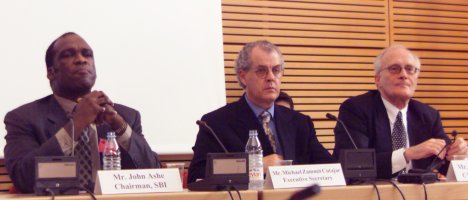 Highlights
from Friday, 15 September: On to the Hague and COP-6 . .
. Highlights
from Friday, 15 September: On to the Hague and COP-6 . .
.
On the final day of SB-13 in Lyon, the Joint Working
Group on Compliance and the contact group on Articles 4.8/4.9 of
the Convention and Article 3.14 of the Protocol met in morning sessions.
SBSTA and SBI met in separate sessions to adopt decisions and a
joint meeting of the subsidiary bodies met in an evening session.
At approximately 10:45 pm, Chair John Ashe suspended SB-13 until
COP-6. COP-6 will take place in the Hague form 13-24 November Photo:
SBI Chair John Ashe, UNFCCC Executive Secretary Michael Zammit Cutajar,
and SBSTA Chair Harold Dovland meet with the press. Story and RealAudio
below.
|
|
 Final
Press Conference Final
Press Conference
In a press conference with UNFCCC Executive Secretary Michael
Zammit Cutajar (top photo, on the left), SBSTA Chair
Harold Dovland (top right) and SBI Chair John Ashe
(bottom photo, left), Cutajar said that "key countries
must start demonstrating real political leadership in order to ensure
strong and effective action is launched to control greenhouse gas
emissions." Outstanding issues were highlighted, including:
how to define carbon "sinks"; how much credit developed
countries can earn from investments in other countries through the
Clean Development Mechanisms; how the non-compliance regime should
work; what specific actions will be taken to address the special
concerns of developing countries that are particularly vulnerable
to climate change; and how much financial and technological support
will go to developing countries. It was also stated that consensus
started to emerge on how to review information supplied by governments
about their emissions. The most recent ratifications of the Kyoto
Protocol, made during the Millennium Summit, were Guinea, Kiribati,
Lesotho, and Mexico. This brings the total of ratifications to 29,
all by developing countries. To date, Mexico is the largest emitter
of greenhouse gases to have ratified the Protocol, ranking 14th
amongst emmiters in 1997.
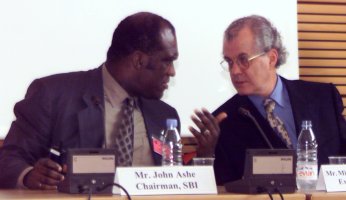  RealAudio from the press conference:
RealAudio from the press conference:
|
|

|
Burkina Faso,
speaking for the Africa Group, congratulated Chair Ashe on SBI's
work. He underscored the need to pay particular attention to the
needs and situations of LDCs. Noting that LDCs did not feel adequately
involved in the work of the GEF, he said the SBI should request
the GEF to focus in particular on Africa, taking into account the
specific needs of each country, and taking a sub-regional approach
to capacity building. He expressed the hope that COP-6 would produce
a successful outcome.
|
|
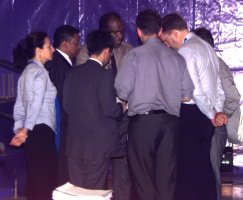
|
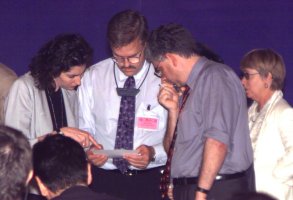
|
| Chair
Ashe noted a request by the G-77/China to elaborate a further document
based on the first one to provide information on trends in greenhouse
gases in Annex I countries in both tables and graphics in time for
COP-6. The US expressed concern at this issue being introduced at
this stage. Following brief informal consultations at the foot
of the dias (above), delegates accepted a proposal requesting
the Secretariat to further elaborate the document in the form of tables
and graphics at COP-6, without prejudice for further compilation at
SBSTA-14. Draft conclusions on national communications from Annex
I Parties will be presented at SBI-13 part II. |
|
Final Joint Meeting of the Subsidiary Bodies
|
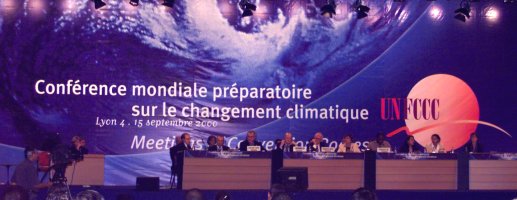
SBI Chair Ashe opened the final joint SBI/SBSTA meeting on the evening
of Friday, 15 September at 9:30. Parties expressed their appreciation
to the Government of France and the City of Lyon for hosting SB-13.
|
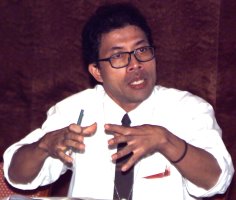 |
 The Indigenous Peoples' Group noted that there are 350-400 million
who identify themselves as indigenous peoples. He expressed opposition
to the use of sinks in the CDM, suggesting it would result in a
violation of the rights of indigenous peoples. He said negotiations
must involve full participation of indigenous peoples and called
for a working group to be formed to address indigenous people's
issues.
The Indigenous Peoples' Group noted that there are 350-400 million
who identify themselves as indigenous peoples. He expressed opposition
to the use of sinks in the CDM, suggesting it would result in a
violation of the rights of indigenous peoples. He said negotiations
must involve full participation of indigenous peoples and called
for a working group to be formed to address indigenous people's
issues.
|
 The
Union of Industrial and Employers' Confederations of Europe (UNICE),
speaking on behalf of the business community,
highlighted that actions taken by business and industry would be
fundamental to Parties achieving the commitments agreed to in Kyoto.
Regarding the mechanisms, he suggested: keeping the process and
procedures for the project-based mechanisms clear and concise; minimizing
transaction costs; not limiting the eligibility and use of any technologies
in implementing the Protocol; and ensuring there are no limits,
ceiling or share of the proceeds type fees apart from in the CDM.
He expressed concern at the lengthy texts currently before SB-13
containing many unresolved issues, and at the significant amount
of work required for a successful outcome at COP-6.
The
Union of Industrial and Employers' Confederations of Europe (UNICE),
speaking on behalf of the business community,
highlighted that actions taken by business and industry would be
fundamental to Parties achieving the commitments agreed to in Kyoto.
Regarding the mechanisms, he suggested: keeping the process and
procedures for the project-based mechanisms clear and concise; minimizing
transaction costs; not limiting the eligibility and use of any technologies
in implementing the Protocol; and ensuring there are no limits,
ceiling or share of the proceeds type fees apart from in the CDM.
He expressed concern at the lengthy texts currently before SB-13
containing many unresolved issues, and at the significant amount
of work required for a successful outcome at COP-6.
|
|
 Regarding mechanisms, India,
on behalf of the G-77/China, stressed that the debate must
not be fragmented into sub-processes, not only for logistical reasons
but also to ensure proper treatment of all the issues.
Regarding mechanisms, India,
on behalf of the G-77/China, stressed that the debate must
not be fragmented into sub-processes, not only for logistical reasons
but also to ensure proper treatment of all the issues.
|
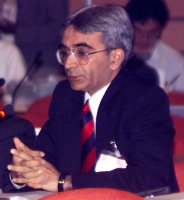 |
|
|
Regarding
capacity building, Croatia expressed concern over the number
of brackets in the text and called for progress in the area of finance
to enable capacity building in EITs. France, for the EU
(left), said it was vital that capacity building in EITs
be ensured in conditions not restricted to the Convention, but taking
into account preparations to enable countries to meet their commitments.
|
 Vanuatu, speaking for the Least Developed Countries, noted
that this group had only established itself recently. He called
on all developed countries to implement their FCCC obligations,
and requested that a workshop be organized for LDCs to focus on
key issues in the lead-up to COP-6.
Vanuatu, speaking for the Least Developed Countries, noted
that this group had only established itself recently. He called
on all developed countries to implement their FCCC obligations,
and requested that a workshop be organized for LDCs to focus on
key issues in the lead-up to COP-6.
|
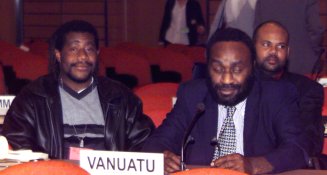
|
 |
 In response to the request made by Vanuatu, Executive Secretary
Zammit Cutajar said
that funding was available, although the issue of timing would have
to be addressed. He suggested that the workshop either take place
in October or immediately prior to COP-6. He also drew delegates'
attention to the fact that there had been a number of recent ratifications
of the Kyoto Protocol. This means that more than half of the 55
countries required, in order for the Protocol to enter into force,
have now ratified.
In response to the request made by Vanuatu, Executive Secretary
Zammit Cutajar said
that funding was available, although the issue of timing would have
to be addressed. He suggested that the workshop either take place
in October or immediately prior to COP-6. He also drew delegates'
attention to the fact that there had been a number of recent ratifications
of the Kyoto Protocol. This means that more than half of the 55
countries required, in order for the Protocol to enter into force,
have now ratified.
|
|

|
 In his closing statement, Nigeria, on behalf of the G-77/ China,
expressed disappointment that more progress had not been achieved
at this critical session in Lyon. He asked whether developed countries
intended to accommodate the priorities of developing countries. He
called for transparency in negotiations, and insisted that each Party
at COP-6 be involved in the decision-making process.
In his closing statement, Nigeria, on behalf of the G-77/ China,
expressed disappointment that more progress had not been achieved
at this critical session in Lyon. He asked whether developed countries
intended to accommodate the priorities of developing countries. He
called for transparency in negotiations, and insisted that each Party
at COP-6 be involved in the decision-making process. |
|
Saudi
Arabia and Brazil expressed support for recognizing the needs and
situations of LDCs. Right: The Saudi Arabian delegation
|

|
|
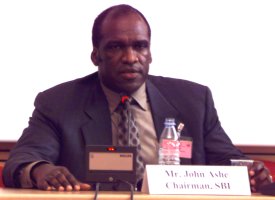
 SBI
Chair Ashe noted that participants had worked very hard,
narrowing differences and producing negotiating texts on most issues
that he hoped would pave the way for a set of decisions at COP-6.
However, he also drew attention to the considerable amount of work
remaining in the lead-up to COP-6, and at COP-6 itself. He hoped
that results achieved in Novemsber would trigger ratification of
the Protocol and further strengthen implementation of the FCCC.
He informed delegates that part II of SB-13 would resume at The
Hague, and suspended the meeting at 10:45 pm
SBI
Chair Ashe noted that participants had worked very hard,
narrowing differences and producing negotiating texts on most issues
that he hoped would pave the way for a set of decisions at COP-6.
However, he also drew attention to the considerable amount of work
remaining in the lead-up to COP-6, and at COP-6 itself. He hoped
that results achieved in Novemsber would trigger ratification of
the Protocol and further strengthen implementation of the FCCC.
He informed delegates that part II of SB-13 would resume at The
Hague, and suspended the meeting at 10:45 pm
Following
these statements, the Secretariat announced informal consultations
during the intersessional period prior to COP-6 relating to:
- Protocol Articles 5, 7 and 8 (6-8 October, Bonn);
- LULUCF (9-11 October, Viterbo, Italy);
- Compliance (12-14 October, New Delhi);
- Mechanisms (16-18 October, New Delhi);
- adverse effects (tentatively scheduled for 19-22 October, Geneva).
(note: RealAudio of the above announcement included in Chair
Ashe's statement)
|
Miscellaneous
photos
|

|
ENB
writers Angela Churie (center) and Lavanya Rajamani (right)
speak with SBI Chair John Ashe about his impressions of the
week's negotiations
|
|
ENBers
Lavanya Rajamani (far left), Andrei Henry and Malena Sell
(far right) interview Ian Fry (Tuvalu)
|

|
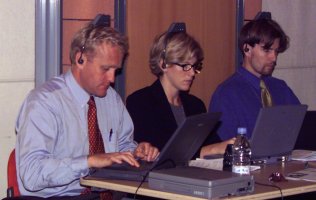 |
(From
left to right) ENB writers Jon Hanks (South Africa), Lisa Schipper
(Sweden), and Chris Spence (New Zealand) sporting the latest in
French fashion for back-of-plenary dwellers...
|
|